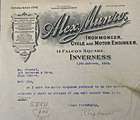| |
Motor Car Act 1903
The registration of road vehicles had been
envisaged in the last decades of the nineteenth century, primarily
to aid the policing of speed limits laid down in acts of parliament
concerning roads. However, a registration system for motor vehicles
was not implemented until 1903, under the Motor Car Act. In Scotland
registration was a function of county councils and town councils
of the larger burghs (Aberdeen, Dundee, Edinburgh, and Glasgow).
From 1904 registers were kept of all motorcars and motorcycles (either
in combined or in parallel registers) and licenses were to be issued
to drivers (although no driving test was required). Number plates
had to be attached to the front and rear of each vehicle, and these
carried a combination of letters and numbers, which identified the
county or burgh of registration. In Scotland all registration numbers
included the letters G, S or V.
Roads Act 1920
In 1919 vehicle registration in the UK was
placed under the supervision of the newly formed Ministry of Transport,
but the administration of the system was left in the hands of county
and burgh authorities under the Roads Act of 1920 (in Scotland the
town councils of Coatbridge, Greenock, Kirkcaldy, Motherwell & Wishaw,
and Paisley became licensing authorities). The Act confirmed the
letter ‘S’ as a vehicle identifier specific to Scotland, but the
letters G and V were no longer to be applied solely to Scottish
registrations. Separate registers for motorcycles were abolished.Record
keeping changed. In addition to the bound register(s) of cars, motorbikes
and licenses issued, registration authorities were now to keep a
record card for each registration mark, and a file on each vehicle.
Although this made vehicle identification easier, the triplication
of record keeping led to local variations in how records were kept,
and in most cases the quality of information entered in bound registers
began to deteriorate, as local authorities put most effort into
keeping and updating the file and card records.
National registration system, 1969
The 1969 Vehicle and Driving Licences Act
set up the centralised (and computerised) Driving and Vehicle Licensing
Centre (DVLC) in Swansea, South Wales. The transition from local
record keeping to national registration was supposed to have been
completed by 1975, but local record keeping in some areas continued
until 31 March 1978. The transition period coincided with the reorganisation
of local authorities in Scotland (and England and Wales) and this
was to have a serious effect on the preservation of the historical
registers and other records.
Survival of local registers
Local registration offices had been instructed,
by the Department of the Environment, to transfer their surviving
vehicle files to the DVLC in Swansea and to transfer registers to
local archive services. However, during the transition period in
the mid 1970s, few Scottish local authorities maintained a professional
archive service, and those that did were heavily involved in the
reorganisation of local government. Those local archive services
that did exist made attempts in the 1970s and 1980s to locate and
preserve surviving local registers and other registration records
with varying degrees of success. Some managed to acquire them directly
from local vehicle taxation offices. In many cases the survival
of records from former counties and burghs was depressingly poor.
Some registration offices may have destroyed records during their
winding-up. Others may have been casualties of the reorganisation
of local government administration. Others appear to have been transferred
to Scottish police forces, some of which, in turn, destroyed them
in the 1980s. Some records passed into private hands, either directly
from local taxation offices when they closed, or via police forces,
when these disposed of records in the 1980s. For a list of surviving
local records see the Frequently Asked Question 1 below.
Bibliography
Philip Riden, How to Trace the History
of Your Car: a guide to motor vehicle registration records in Great
Britain, Ireland, the Isle of Man And The Channel Islands (Cardiff,
1998). J.G.L. Wright (ed.), Dundee Motor Registrations TS1 -
TS1000, (Friends of Dundee City Archives, 2003), available via
the Friends
of Dundee City Archives website)
|
|
|
|

1
Where can I find registration records for former (pre-1978) Scottish
vehicle licensing offices?
2.
How can I tell where a car was registered from its pre-1978 registration
plate?
3:
What sort of information will a vehicle or licensing register for
a county or burgh tell me about a vehicle and its owner(s)?
Image 1

Letter concerning vehicle registration enclosed
in the Inverness County Register of Motor Cars (Highland Council
Archives).
Image 2

Register of Motor Cars for Inverness-shire
(Highland Council Archives).
|

![]()

